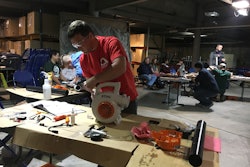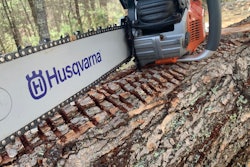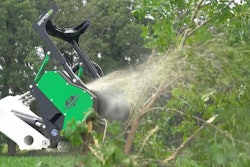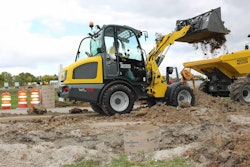 John Deere introduced the Michelin X Tweel Turf airless radial tire to eliminate flats and most tire maintenance, boosting landscapers’ productivity.
John Deere introduced the Michelin X Tweel Turf airless radial tire to eliminate flats and most tire maintenance, boosting landscapers’ productivity.Photo: John Deere
Want to download the entire Mower Matchup series, including makes, models and details on dozens of mowers from the editors at TLC?
If you had to sum up what matters most to landscapers when it comes to their mowers, it boils down to operator comfort and efficiency.
“Reducing operator fatigue leads to greater productivity, while increased unit performance yields better results and reduced time on the job,” says Tom Vachal, Kubota senior turf product manager.
The focus on comfort and productivity is also linked to the ongoing labor shortage the industry is facing.
“For landscape professionals specifically, a reduction in operator fatigue can help crews deliver better productivity,” says Jamie Briggs, director of marketing for Exmark. “It’s also a benefit to employee retention, which is a big deal in today’s tight labor market.”
In response to this demand for comfort, manufacturers have created suspension systems, such as Toro’s MyRIDE and John Deere’s ComfortGlide. These suspension seats are designed to absorb bumps and provide a smoother ride for operators.
Mower manufacturers have also worked to enhance user comfort on stand-on mowers by improving the weight distribution and ergonomics.
“Any landscape contractor knows comfort makes a big difference when it comes to their crew’s productivity,” says Chris Vogtman, senior marketing manager at Toro. “The more comfortable an operator is, the more productive he or she will be in the field. At a time when landscape contractors are continually pressured to accomplish more tasks with fewer resources, it’s important to keep a company’s most important asset — its people — comfortable, safe and productive from start to finish of their day.”
 The MyRide suspension system has five different comfort level settings for operators to choose from.
The MyRide suspension system has five different comfort level settings for operators to choose from.Photo: Toro
Selecting equipment that is designed to limit physical stress and strain not only helps boost morale and productivity, it can also reduce turnover, positively contributing to a contractor’s bottom line, Vogtman adds.
Manufacturers are going about improving efficiency in a number of different ways. Some are working to reduce maintenance requirements so there is less downtime. For example, John Deere introduced the Michelin X Tweel Turf airless radial tire on select ZTrack and QuikTrak mowers to eliminate flats and most tire maintenance.
Exmark says that they have simplified the operation of their latest mowers so there is less training required for new users to operate them.
Bob-Cat recently introduced its new Predator-Pro 7000 series, which has a 2-speed option that allows landscapers to travel up to 19 mph when moving between sites.
“The time that landscapers can save by getting back to their trailer quicker allows them to take care of a few extra customers during the work day,” says Ron Scheffler, Bob-Cat’s senior product manager. “Also, our new AirFX cutting system, which includes our Air-Gap baffle design, provides the landscaper with a cleaner deck at the end of the day, so they can focus more on mowing and less on cleaning.”
In response to requests for more versatility, Toro offers its GrandStand Multi Force series, which uses a number of attachments on one machine.
John Deere is also trying to improve landscapers’ versatility with its popular Mulch on Demand (MOD).
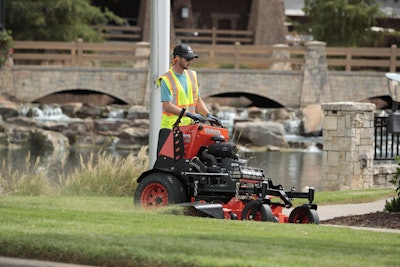 Comfort on stand-on mowers have been improved with better weight distribution. Photo: Kubota
Comfort on stand-on mowers have been improved with better weight distribution. Photo: Kubota“MOD enables the operator to switch between mulching and side-discharging without ever leaving the seat,” says Nick Minas, product marketing manager for John Deere. “Mulch on Demand reduces the time spent cleaning up clippings from driveways and sidewalks by allowing the operator to easily close off the discharge chute.”
When it comes to current demands, zero-turn mowers continue to dominate. Toro notes, however, that many landscape contractors are adopting stand-on mowers due to their smaller footprint.
Similarly, Gravely has reported that there has been a strong response to their Pro-Turn Z and Pro-Turn ZX, which are designed for smaller contractors or those just getting started.
“The attractive price point on these products makes it easier for someone to get into the business with a machine that meets commercial needs,” says Matt Medden, vice president of marketing for AriensCo.
There’s also the trend toward robotic mowers, which is an initial step toward autonomous mowers. “The industry is still a long way away from an autonomous mower being able to match the precision and detail of an experienced landscaper,” Vogtman says. “When we are able to provide a fully autonomous mower to the marketplace, the unit will be a highly practical solution that doesn’t sacrifice quality of cut.” (For a more thorough discussion of robotic mowers, stay tuned for the story tomorrow.)
Battery-powered mowers
Prompted by customer awareness of battery technology and rising fuel prices, mower manufacturers are seriously developing approaches to battery-powered machines.
Mean Green Mowers and Greenworks have come out with commercial battery-powered zero-turn mowers.
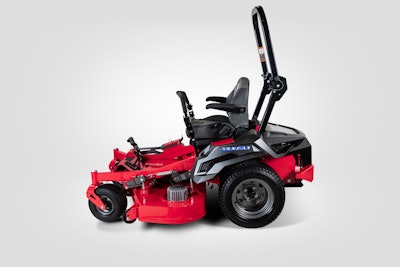 The EVZT is a prototype of Gravely’s first lithium-ion battery-powered commercial mower.
The EVZT is a prototype of Gravely’s first lithium-ion battery-powered commercial mower.Photo: Gravely
Gravely teased their first lithium-ion battery-powered commercial mower, the EVZT, at the 2018 GIE+EXPO. At the press event, Medden said AriensCo wanted to be leaders in the industry rather than fast followers.
“We know there are competitive products in the market, but our research has shown that these products are not hitting the mark when it comes to the unique needs of commercial cutters,” Medden says. “While we aren’t ready to release our electric-powered zero-turn and still have an extensive amount of testing to do, we know that when we bring this unit into production, it will be a true commercial machine.”
Several requirements need to be met before battery power is viewed as a viable power source, including all-day runtime, improved charging times, lower cost and safety.
“The battery technology itself is there, but we need to make sure it’s done safely,” Medden says. “With lithium-ion technology, you’re storing a lot of power, so how do you make sure that’s done in a safe manner? We also need to think of total cost of ownership. You can buy a commercial zero-turn today for about $12,000, or an electric-powered machine for around double that. The thing is, over the life of the machine, the savings in gas, oil changes and maintenance will save the contractor immensely. We just need to change the mindset of the buyer from looking at the upfront cost of a battery-powered zero-turn to looking at the total cost of ownership for that machine.”
Toro also stresses that even if a battery-powered mower can meet all that criteria, it has to perform equal to, if not better than, a gas-powered machine.
“We’re a mower manufacturer first, which means that we will always put more emphasis on the overall performance of our machines and the results it provides before evaluating alternative power sources,” Vogtman says.
Implementing fleet tracking systems
Telematics are becoming more popular in mower fleets as landscapers look to improve their operations through the data collected with equipment tracking systems.
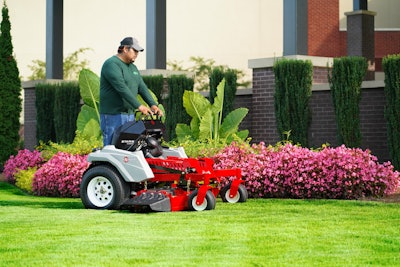 Reducing operator fatigue can help crews deliver better productivity, which
Reducing operator fatigue can help crews deliver better productivity, whichis why ergonomics are more important on mowers.
Photo: Exmark
“As more landscapers realize the benefits of data collection, we anticipate increased interest,” Minas says. “We are continuing to work with our customers to address their business needs and introduce new product offerings that will help them be more productive and efficient.”
Toro has had its Horizon platform for five years, providing fuel usage and machine status alerts for landscapers who have Z Master mowers. Vogtman indicates that the company will focus on offering tools and technology to keep their machines at optimum performance while also examining telematics solutions.
Briggs & Stratton rolled out its InfoHub fleet tracking service in 2017 and Husqvarna is set to debut its Fleet Services in 2019.
“The big advantage Husqvarna’s Fleet Services has is that we have already tested our software for several years in live environments with real landscaping companies and have had several years to optimize it based on those experiences,” says Sean Dwyer, director of product development for Husqvarna.
Manufacturers expect that as these services become more commonplace, more companies will add telematics capabilities.
“Companies that can add value beyond just the whole good will ultimately be the winners, and investment in this space means only good things for contractors and consumers,” Vogtman says.
The future
One element of the future that many brands are uncertain about is whether there will be more regulations on machinery emissions. Toro says it’s not outside of the realm of possibility for more emission standards to roll out, and is prepared to address any additional environmental rules.
“California and other states will continue to push for reduced emissions on turf products; those will take some time for the industry to develop the products to meet these (hypothetical) new emission requirements,” Vachal says. “A huge group of small landscapers will continue to use their products that don’t meet these requirements unless certain destroy provisions are implemented (which would require owners to destroy non-compliant equipment).”
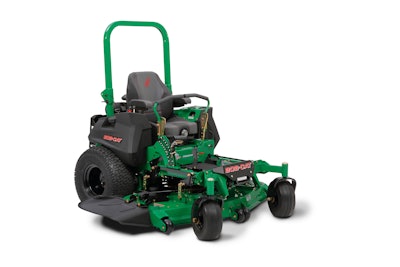 The Bob-Cat Predator-Pro 7000 has a 2-speed option that allows landscapers to travel up to 19 mph when moving between sites.
The Bob-Cat Predator-Pro 7000 has a 2-speed option that allows landscapers to travel up to 19 mph when moving between sites.Photo: Bob-Cat
Mower manufacturers expect the market will continue to grow as the industry becomes even more technologically advanced and connected.
Medden says the “do it for me” mindset among homeowners will cause more people to bid out jobs versus doing the work themselves.
“I think we will see tremendous growth in alternative power technologies and autonomy,” Medden says. “In my opinion, the landscape of this industry will look a lot different in five years.”
Vogtman says that the mower market will continue to be driven by the need to do more with fewer resources.
“I believe products that reduce time for the commercial contractor will be the next area of development for the mower industry,” Vachal says. “More customers are using commercial contractors for turf maintenance and as the demand grows, they will need to reduce time on the job to be competitive.”
EDITOR’S NOTE: This is one of the articles found in Mower Matchup. Mower Matchup was created to delve into the pros and cons of various mower features and provide a comprehensive look at popular mower manufacture specs. Click here to download the full Mower Matchup series.
